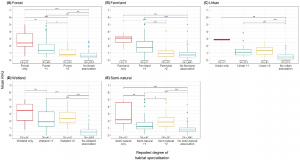Relative habitat use metric accurately quantifies species’ habitat association and degree of specialization
March 1, 2022
In February, scientists from the University of East Anglia in collaboration with the PECBMS network published new research on species’ habitat association in Ecological Indicators. They explored the ‘relative habitat use’ (RHU) metric as a means of quantifying species’ habitat association and degree of specialization. The authors recommend the RHU metric as a useful tool in conservation management strategies to protect habitat specialists and their habitats, and thus support national and international progress towards reaching biodiversity targets.

Skylark (Alauda arvensis) is reported in the literature as being specialized to farmland habitat and showed to have the highest mean RHU for farmland. Photo by Caroline Legg
To understand species’ sensitivity to habitat change, we must correctly determine if a species is associated with habitat or not, and if it is associated, its degree of specialization for that habitat. A recently published study conducted by the University of East Anglia explored the use of the ‘relative habitat use’ (RHU) metric as a means of quantifying species’ habitat association and degree of specialization. The study found that when comparing RHU scores to literature-based classifications for bird species’ association with and degree of specialization for European habitats, the two were generally well-aligned.
Classic definitions for species’ habitat association and specialization are often static, categorical, literature-based classifications that coarsely define species as habitat specialists or generalists which may fail to account for potential temporal or spatial differences in association and specialization. However, quantitative metrics, such as RHU, can provide a more nuanced assessment of associations and specialization as scores are placed along a continuous scale and they can accommodate for any temporal or spatial variation.
RHU determines the extent of a species’ association with a given habitat by comparing its abundance in that habitat relative to its mean abundance across all other habitats. Using PECBMS count data for 246 bird species across Europe from 1998 to 2017, the authors calculated RHU scores for each species for five broad habitat types and compared them to the literature-based classifications of their association with and specialization for each of these habitats.
The study found that species demonstrated higher RHU scores for habitat(s) they were reported as being associated with in the literature. Similarly, species reported in the literature as being associated with a given habitat had higher RHUs for that habitat compared to species not reported as being associated with it. RHU also distinguished species according to their degree of habitat specialization, with species reported in the literature as being more specialized to a given habitat having higher mean RHU scores for that habitat compared to generalist species that were reported as being associated with the habitat.

Figure 1. Species mean RHU scores for five broad habitat types. Within the panel for each habitat, species are grouped according to their reported degree of habitat specialization, determined by the number of habitats they have been reported in the literature as being associated with or if not reported as being associated with the panel habitat. The sample size for each group is given under each boxplot. Pairwise comparisons showing significant differences are also identified (* p<0.05, ** p<0.01, *** p<0.001).
Enya O’Reilly, a Ph.D. student at UEA’s School of Biological Sciences that conducted the analyses said: “We expected literature-based classifications and RHU to align with one another as both methods rely on observations of species’ abundances across habitats to characterize their habitat associations. However, overall RHU is more robust than literature-based classifications as it is a quantitative method that is based on the most widely available data, can be calculated at any temporal or spatial scale, and can differentiate species based on the extent of their association with or degree of specialization for a given habitat.”
The authors also explored the temporal variation in species’ RHU scores for each habitat and assessed how this varied according to association and degree of specialization. From this, they found that species associated with a given habitat showed lower variation in RHU scores for that habitat over time compared to species not associated with it and, species more specialized to a given habitat showed less variation in their RHUs for that habitat over time compared to more generalist species. O’Reilly explains that these results give us further confidence in using RHU to classify species as associated with or more specialized to a given habitat as these species are unlikely to vary in their habitat associations over time.
The authors concluded: “We recommend that the RHU metric should be considered further as a useful tool to identify and classify species by their habitat associations and degree of specialization. Doing so would support conservation management strategies to protect habitat specialists and their habitats, and thus support national and international progress towards reaching biodiversity targets.”
This research was only made possible by the thousands of volunteers who have collected the data that underpin this study. A big thank you to all of you!
We would also like to thank the national coordinators who kindly agreed to share their countries’ data with us and for providing feedback on this paper!
PECBMS is funded by the European Commission (Service Contract No 07.0202/2019/821208/SER/ENV.D.2). The research also benefitted from a National Environment Research Council CASE studentship, as part of the EnvEast/ARIES DTP (student number 100248757), partly funded by the Royal Society for the Protection of Birds.
Citation of the paper:
Enya O’Reilly, Richard D. Gregory, Ainars Aunins, Lluís Brotons, Tomasz Chodkiewicz, Virginia Escandell, Ruud P.B. Foppen, Anna Gamero, Sergi Herrando, Frédéric Jiguet, John A. Kålås, Johannes Kamp, Alena Klvaňová, Aleksi Lehikoinen, Åke Lindström, Dario Massimino, Ingar Jostein Øien, Jiří Reif, Eva Šilarová, Norbert Teufelbauer, Sven Trautmann, Chris van Turnhout, Thomas Vikstrøm, Petr Voříšek, Simon J. Butler 2022: An assessment of relative habitat use as a metric for species’ habitat association and degree of specialization. Ecological Indicators, Volume 135, 108521, ISSN 1470-160X, DOI: 10.1016/j.ecolind.2021.108521


